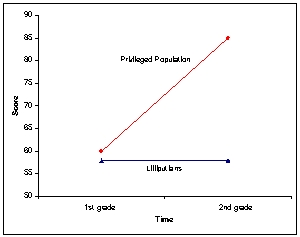Not Answered
Evaluators were interested in the long-term efficacy of a new early intervention education programs for Lilliputians, by far the most underprivileged population in the world. There had been considerable past research that showed without intervention, academic achievement in Lilliputians actually gets worse over time, whereas achievement in privileged populations tends to increase. For example, in a previous cross-sectional assessment of achievement, the average academic achievement for these populations is provided in the table below. To investigate the effect of this program on Lilliputians' subsequent academic achievement, the researchers decided to give themselves the best possible chance of detecting a treatment effect and compare the achievement of the highest performing Lilliputians to students from the privileged population with similar scores on the pretest (i.e., the lowest performers from the privileged population). Their results can be seen in the figure below. They conclude that the educational program was a bust, as it appears that even the best Lilliputians showed no change in their academic aptitude, while those in the privileged population, who were not exposed to any treatment, improved considerably. Was their conclusion warranted? In your response, (a) explain whether their conclusion was warranted or not; (b) explain how regression toward the mean might be affecting the results for both populations; (c) explain whether you think the education program was successful - in other words, based on what you know about regression toward the mean, discuss the likely outcomes for both populations in the absence of any treatment, and then compare that to the observed results when a treatment was present for the Lilliputians. (d) Finally, if you had all of the resources available in the world, provide an example for how you could use a regression discontinuity design to test for the causal effects of an educational intervention on the worst-performing Lilliputians. Be sure to describe the time frame of the study and how often data points would be collected, how participants would be assigned to groups, and after the intervention is applied, how you would determine whether it had an effect.

Correct Answer:

Verified
Correct Answer:
Verified
Q20: Not all social programs are amenable to
Q21: The "Stroop" Task is an example of:<br>A)
Q22: What conditions must be met to be
Q23: Describe the basic and defining features of
Q24: Which of the following graphs reflect possible
Q26: With propensity scores analyses, the difference between
Q27: In terms of internal validity (i.e., least
Q28: This type of evaluation is used to
Q29: Which of the following techniques is an
Q30: You are interested in how teenagers think